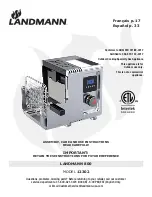
B102233-1-0914
Page 23
Attach the LP hose and Regulator to
the fitting on the Burner Control
Valve mounted on the Control Panel.
Tighten this connection with a wrench.
3/4”
For Natural Gas Grills please proceed
to page 26.
LP GAS REGULATOR AND HOSE
Grill Location
This grill is designed for outdoor use only.
Never operate your grill in any building, garage, or other
enclosed area. Never operate your grill in a recreational vehicle
or boat. Never operate your grill under any combustible materials,
such as carports, covered porches, awnings, or overhangs.
CAUTION
K
eep the sides of the grill at least 16 inches from any
combustible material. Keep the back of the grill at least
18 inches from any combustible material. Placing a hot
grill too close to a building or other combustible
material may lead to fire, property damage, or personal
injury. Combustible materials include fences, patio fur-
niture, and your home.
Keep the area around the grill clear to ensure proper ventilation.
The ventilation openings on the propane cylinder enclosure must
also remain free and clear of debris.
Before lighting the grill, position it on a level surface away from
direct wind.
Never move a hot grill.
WARNING
D
o not install or operate this grill where gasoline or other
flammable materials are used or stored. Failure to comply
with this warning could result in explosion or fire causing
property damage or personal injury.
Propane Cylinder Safety
Propane vapor fuels your grill. Propane is a liquid only when it
is highly compressed. Keeping it compressed requires a heavy-
duty tank - the LP cylinder.
Inside a full cylinder, the liquid propane makes up the bottom
80 percent; while propane vapor makes up the top 20 percent.
As you draw this vapor from the top of the tank, the liquid below
expands and turns to vapor. Once all of the liquid turns to vapor,
pressure inside the cylinder drops and gas flow stops.
Liquid Propane (LP) gas has a long history of safe use when the
safety precautions provided in this manual are followed.
Failure to follow these safety precautions could result in
a fire or explosion causing property damage or personal
injury.
Use extreme caution when handling propane gas cylinders.
Keep the cylinder upright while carrying.
While transporting in a vehicle, keep the cylinder upright and
secured to prevent movement. Never place a propane gas cyl-
inder in the passenger area of a vehicle.
Replace any cylinder that has been dropped, dented, has a
malfunctioning valve, or is visibly damaged. Never attempt to
use or repair a damaged propane gas cylinder.
When refilling your cylinder, always insist on a reputable, quali
-
fied gas dealer. Your propane gas cylinder is filled by weight, and
should never exceed eighty percent (80%) of its weight limit. If
the cylinder is not completely empty, the gas dealer must make
adjustments to ensure it is not overfilled. Never use an overfilled
Propane gas cylinder.
When you finish grilling, turn off the grill’s burners and turn off
the gas at the cylinder. If the grill will not be used for an extend
period, remove the cylinder from the grill for storage.
Cylinder Storage
Store your grill outdoors in a well-ventilated area when the LP
cylinder is attached to it.
Store Propane cylinders in a secured upright position.
Keep children away from LP cylinders.
Store cylinders out of direct sunlight and well away from heat
sources. Do not store cylinders in a building, garage, or other
enclosed area.
Disconnected cylinders must have a threaded valve plug tightly
installed.
Do not store flammable materials near LP cylinders - including
gasoline, paper, grill covers, etc.
PROPANE GAS GRILLS
















































